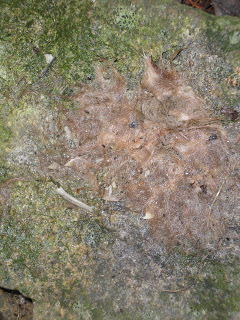The hike in to the cabin is a rocky 1.4 mile downhill walk, so be sure to bring appropriate footwear to protect your feet and help support pack weight. If you have your own pack, sleeping bag and pad, please bring them. For Lodgers without equipment we will have a brief equipment orientation session before we leave and supply what is needed.
Corbin Cabin is on the National Register and seems to be known even in Japan since we encountered about a dozen Japanese hikers resting nearby when we arrived. Even though we're in the dry time of the summer, the nearby Hughes River (really more of a creek) is flowing nicely and might even offer a few good swimming holes for the hearty - bring your bathing suit!
Though it looks like a lonely cabin, Nicholson Hollow was actually one of several settlements as described in The Displaced:
"European settlement was inaugurated in the broad Weakley Hollow valley in the mid-eighteenth century with the legal patenting of large tracts of land which quickly attracted farmers, millers, and merchants. The strongly-flowing streams of the hollow supported at least one grist mill, two sawmills, and a host of legal distilleries, while a road through the hollow connected these businesses with two villages. By the early 20th century, Weakley Hollow boasted its own village, complete with a post office, two churches, two stores, and a school. In 1932, residents owned properties varying from one to 470 acres, living in frame and log houses ranging from the spacious three story home of Haywood and Daisy Nicholson, to the single-story log home of Tera Weakley. Perched high on the slopes of Old Rag Mountain, the newly-abandoned Weakley home was easily missed when the CCC boys swept through the hollow on their mission to restore nature. The house and nearby henhouse stood nearly intact until November 2000."
In 2000 there was a huge forest fire that destroyed many of the buildings and we could see the signs of an old fire all around us. The building itself is a text, showing the marks of making. In the image below the left circle highlights the marks of an "adze" that was used to shape logs and the right circle features an example of the "dovetail notch" style of cabin assembly.
Even the trail is a text to be read, full of fascinating detail for the attentive hiker. On our way up the mountain we encountered two strange things on the trail - can you identify what they are?

The image on the left is of an Owl pellet....see the tiny bones & hair?
The identity of the second image is not for the squeamish. Can you see that small brownish triangle in the lower right part of the mass?
It's part of a deer hoof, most likely a fawn, in a large dark pile of bear droppings (aka spoor, crap, manure...).
While we are not likely to have any encounters with bears, this is a reminder that the Bambified image of nature we sometimes see in the media is not accurate. Nature, though beautiful, is "red in tooth & claw."





No comments:
Post a Comment